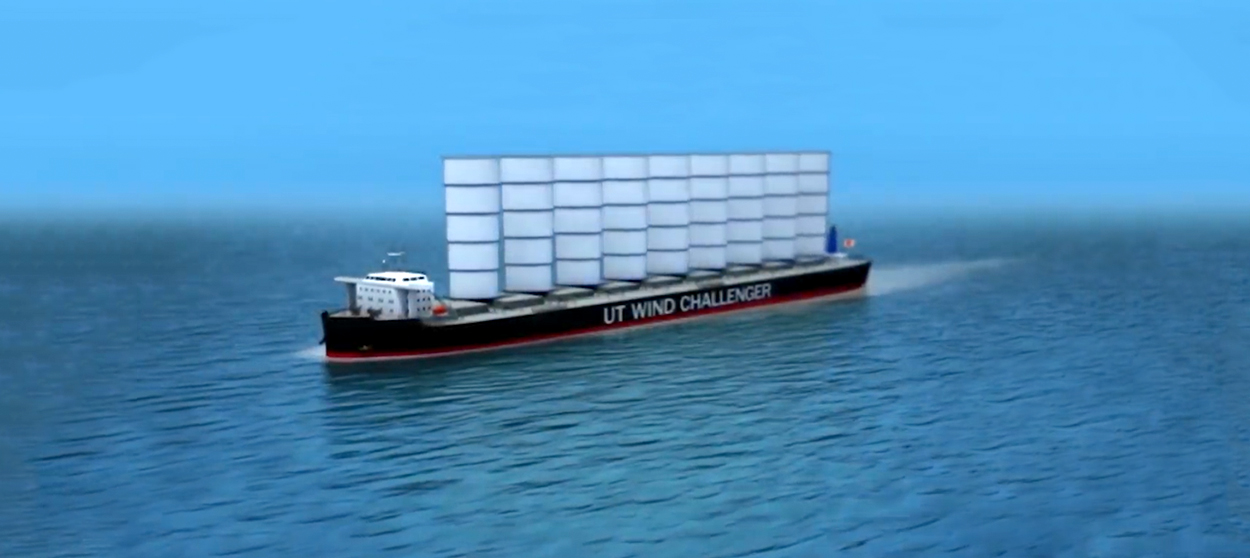Why cargo ships might (literally) sail the high seas again
International shipping is getting back into wind power


There's something inherently romantic about the great ships of yore: Those massive sails piercing the sky above an endless horizon.
These days, of course, we've given up the sails for the brute force of fossil fuel engines. The modern shipping industry has sacrificed elegance — not to mention the environment — for volume, speed, and efficiency.
But those old sails may be coming back.
The Week
Escape your echo chamber. Get the facts behind the news, plus analysis from multiple perspectives.

Sign up for The Week's Free Newsletters
From our morning news briefing to a weekly Good News Newsletter, get the best of The Week delivered directly to your inbox.
From our morning news briefing to a weekly Good News Newsletter, get the best of The Week delivered directly to your inbox.
There's an overarching organization — the International Windship Association — that's pushing wind propulsion for commercial shipping, and liaising between various governments and entrepreneurs and researchers. But then there are the specific projects, scattered about the globe, in both private business and academia.
Take the Smart Green Shipping Alliance as an example. It's working on a combination of sailing technology and clean fuel to reduce cargo ships' CO2 emissions, hopefully to zero eventually. Diane Gilpin, who founded and heads up the initiative, explained to The Week that they're working on two goals. One is a cargo ship designed from the keel up for sailing, with an optimized hull and so on. The idea has been run through computer simulations and some testing of physical models, and they think as much as 50 percent of the propulsion could come from the sails. "If we do it from scratch we can get better performance results than if we have to retrofit an existing ship," Gilpin explained.
But building new cargo ships, especially technologically-advanced sailing-optimized ones, is expensive. And like much of the global economy, the shipping industry is in an uncertain spot right now.
Thus Gilpin and her colleagues are also looking into retrofitting existing cargo ships. "We want a plug-and-play type system," she said: Ships come into port, they offload their cargo, the sails are installed as new cargo is loaded in, and the ship heads off again. Quick and easy. The sails would be adjustable and retractable, so they can stay out of the way of the loading dock cranes, or when the ship goes under a bridge or maneuvers into port.
A free daily email with the biggest news stories of the day – and the best features from TheWeek.com
The group has been refining the design, getting feedback from players in the industry, and then going back to the drawing board. They're on their third iteration and hope to begin a demonstration project with a fully retrofitted ship in 2021. They think their retrofitted sails could cut 20 percent of fuel consumption.
The Wind Challenger Project, which was started by the University of Tokyo, in conjunction with private shipping companies in Japan, is aiming for much the same goal: A system of sails that can be attached to current cargo vessels, that are maneuverable and retractable, and could cut fuel use by 20 percent. In a further convergence, the sails the two projects are working on even look similar: large, rectangular, multi-sectioned affairs that soar vertically from the ship's deck. Kazuyuki Ouchi, a professor at the University who leads the effort, told The Week they too hope to test a full scale model as soon as 2021.
There are also some more oddball projects out there.
A Danish company called Maersk Tankers is testing out giant rotating cylinders that would sit atop its cargo ships. This system takes advantage of a quirk in the physics of air circulation: By spinning, the 100-foot cylinders pull the air around them, creating higher pressure on one side of the cylinder than the other. That differential pushes the ship forward. Maersk is testing the idea out on one of its tankers, and hopes to cut fuel use by as much as 10 percent. If they're successful, they think they could use the cylinders on around 80 of their 164 ships.

Then there's the Vindskip, designed by Lade AS out of Norway. In this case, the ship itself would be the sail; it's tall and relatively thin, like an airplane wing. That would allow the ship to sail more directly into the wind and still generate forward motion. The designers hope they can cut fuel use by 60 percent, and get the remaining propulsion from natural gas. It's not clear when the first Vindskip will sail, though they were looking to launch the first as soon as this year.

Why all the sudden interest in wind propulsion for maritime shipping? A few reasons.
One is technological advancement. The basic physics of sailing haven't changed. But modern material engineering can create sails and rigging that are much stronger and much lighter than what we could get a few decades ago — never mind a century ago. Global weather analysis and big data crunching also open up new possibilities: We've actually gotten very good at predicting how much wind a ship can expect, in the aggregate, along different routes and at different times of the year. Part of the Vindksip's appeal, for example, is an accompanying software packet that would make use of that data for day-to-day navigation.
Then of course there's the climate angle. Cargo ships are only one piece of a much bigger puzzle; they account for roughly 3 percent of humanity's carbon emissions. Still, every little bit counts.
Environmental concerns also bleed into economic ones. Fuel alone is around two-thirds of the industry's operating costs, and fuel prices are already rising. The International Maritime Organization — the United Nation's regulatory body for the global shipping industry — is getting ready to roll out new rules for cleaner burning fuel. It's not just carbon emissions that's a concern; it's sulfur and the like. No one in the industry is really sure how much qualifying fuel will be available, where, and when. The more cargo ships can rely on wind, the more certainty they can get regarding their operating costs. As Gilpin put it, "the wind is free and will always be free, and we can predict it."
In fact, the Smart Green Shipping Alliance has an even grander vision. They'd like to use wind power to generate electricity (Gilpin got her start in wind renewables), use the electricity to generate clean fuel (probably hydrogen), and then use the fuel in conjunction with wind sailing for propulsion. Since wind would drive the entire supply chain, and wind is predictable, this approach could provide the industry a fixed and reliable price for all its propulsion needs. When fuel is 60-to-70 percent of your operating costs, and the average ship lasts 20 years or more, that's a big deal.
Of course, wind won't be a panacea, either. The sails that Gilpin and Ouchi and others are working on are best applied to bulk carriers and tankers; hauling oil, liquids, or grain and such. They have the deck space. The ships with the big stacks of cargo containers don't really have the room. If you estimate the global cargo shipping fleet at 50,000, the Alliance's sails could probably apply to around 10,000 of those ships.
But part of what's powering the drive to get these systems up and running is hope. Testing and experience in real-world conditions is how you learn and advance the technology. Once that process begins, who knows what we could learn, or what techniques and technologies we could still develop? Gilpin compared the possibilities to her early work in wind power: The first turbines her company built were mere 45-kilowatt machines. Twenty years later, they were constructing 12-megawatt turbines on floating offshore vessels. "What we're doing now is the critical first stage," she told The Week. "It won't be anything like what we expect in 10 years or 15 years time."
Who knows? Maybe the romance of the old sailing vessels could yet return.
Jeff Spross was the economics and business correspondent at TheWeek.com. He was previously a reporter at ThinkProgress.
-
 Turner Prize 2025: ‘artistic excellence’ or ‘cultural nonsense’?
Turner Prize 2025: ‘artistic excellence’ or ‘cultural nonsense’?Talking Point Work by the four artists nominated for this year’s award is on display at Bradford’s Cartwright Hall
-
 Man vs Baby: Rowan Atkinson stars in an accidental adoption comedy
Man vs Baby: Rowan Atkinson stars in an accidental adoption comedyTalking Point Sequel to Man vs Bee is ‘nauseatingly schmaltzy’
-
 Goodbye June: Kate Winslet’s directorial debut feels like a ‘John Lewis Christmas TV ad’
Goodbye June: Kate Winslet’s directorial debut feels like a ‘John Lewis Christmas TV ad’Talking Point Helen Mirren stars as the terminally ill English matriarch in this sentimental festive heartwarmer
-
 How do you solve a problem like Facebook?
How do you solve a problem like Facebook?The Explainer The social media giant is under intense scrutiny. But can it be reined in?
-
 Microsoft's big bid for Gen Z
Microsoft's big bid for Gen ZThe Explainer Why the software giant wants to buy TikTok
-
 Apple is about to start making laptops a lot more like phones
Apple is about to start making laptops a lot more like phonesThe Explainer A whole new era in the world of Mac
-
Why are calendar apps so awful?
The Explainer Honestly it's a wonder we manage to schedule anything at all
-
 Tesla's stock price has skyrocketed. Is there a catch?
Tesla's stock price has skyrocketed. Is there a catch?The Explainer The oddball story behind the electric car company's rapid turnaround
-
 How robocalls became America's most prevalent crime
How robocalls became America's most prevalent crimeThe Explainer Today, half of all phone calls are automated scams. Here's everything you need to know.
-
 Google's uncertain future
Google's uncertain futureThe Explainer As Larry Page and Sergey Brin officially step down, the company is at a crossroads
-
 Can Apple make VR mainstream?
Can Apple make VR mainstream?The Explainer What to think of the company's foray into augmented reality
